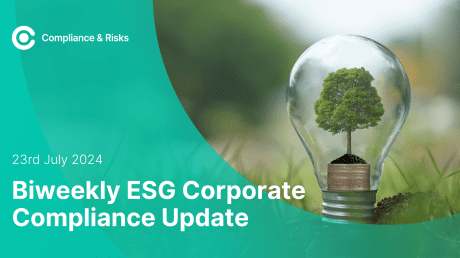
The Weekly Pulse: 5th – 9th December

What’s HOT in our Regulatory World
What are our clients looking at?
This week’s trending sources in C2P
- Spain: Control Measures for the Import of Electrical and Electronic Equipment, Batteries and Accumulators, Royal Decree 993/2022
- Philippines: Implementing Solid Waste Management Act RA 9003, Administrative Order AO 34, 2001 – Proposed Amendment – (on implementation of the extended producer responsibility scheme) Draft Regulation, November 2022
- EU: Packaging and Packaging Waste, Draft Regulation, November 2022
What is our Content Team talking about?
Turkey: Product Tracking System (ÜTS) – GS1 Integration – Dila Sen
On 21 November 2022, the Turkish Medicines and Medical Devices Agency published an announcement about the GS1 integration of the Product Tracking System (Ürün Takip Sistemi/ÜTS).
The ÜTS allows information regarding medical devices, cosmetics and Type -1 and Type 19 biocidal products that come into contact with the human body to be obtained through product barcodes.
The ÜTS infrastructure allows the registration of barcodes in accordance with the formats determined by the barcode allocation agencies. Records are currently taken with the barcodes of the GS1 barcode allocation agencies for:
- Medical devices: GS1 – HIBBC – ICCBBA and IFA
- cosmetics and biocidal products type 1- type 19: GS1
Currently, the majority of product barcodes registered in ÜTS are in GS1 format. Web service integration was carried out with the GS1 Turkey Foundation, the Turkey representative of the GS1 Organization, for the control of barcode and barcode owner institution information.
With the first update to be made on ÜTS as of the beginning of 2023, the accuracy of barcode and company information will be checked for products to be registered as “product (imal)”, and the registration of barcodes that cannot be verified will not be allowed.
The barcodes of products already registered in the system will also be checked for accuracy. Records that do not match barcode and company information will be detected, and necessary applications will be carried out in this manner in the next period.
You may find the aforementioned announcement in this link.
What are our Knowledge Partners talking about?
EU Packaging Directive, Commission proposals for recast – Rina
The European Commission has published proposals (1) to revise the Packaging and Packaging Waste Directive. This will repeal the current Directive 94/62/EC and associated amending legislation. The published proposals are extensive, having 65 Articles, and is much more complex than the previous directive which has 25 Articles. A brief summary of the proposed legislation follows:
- Article 1 states that the directive will cover all packaging and is based on EU Circular Economy Policy. Annex I lists packaging types and also what is not packaging.
- Article 3, the list of definitions is greatly expanded with many new definitions. This states that packaging includes tea bags and single-serve units. Several new economic operator definitions are added including e-commerce, appointed representatives and final distributors.
- Article 5 lists the substance restrictions which are initially unchanged. However, the Commission may, based on scientific progress, reduce the limits on lead, cadmium, mercury and hexavalent chromium.
- Article 6 states that all packaging shall be recyclable, and design for recycling criteria will be adopted which packaging must meet by 1 January 2030. These criteria will be decided by a future Delegated Act. By 1 January 2035 there will also be recyclability at scale requirements. It is also proposed that producers’ financial contributions will depend on the recyclability of packaging based on a “recyclability performance grade” which will be defined by a Delegated Act. By 1 January 2030, packaging that meets the lowest grade will not be regarded as recyclable and so will not be permitted.
- Article 7 regards the minimum recycled content of plastic packaging with specific levels given for certain types and one for all others. This will commence on 1 January 2030 when the recycled content of undefined plastics will be 35% and by 1 January 2040 this increases to 65%. There will be some exclusions such as packaging for medical devices and IVD medical devices and it will not apply to compostable packaging. From 1 January 2030, financial contributions will also be dependent on recycled content as well as the recyclability criteria in Article 6.
- Article 8 defines compostable packaging and Article 9 describes packaging minimisation.
- Article 10 lists the requirements for re-usable packaging.
- Article 11 defines the labelling requirements. These will include the material’s composition, whether it is returnable or re-usable and a QR code or other form of digital data carrier to provide further information.
- Articles 13 to 18 lists the obligations of manufacturers, suppliers (information requirements), authorised representatives, importers, distributors and fulfilment service providers. This new directive will have more types of economic operators with responsibilities than previously.
- Article 21 regards excessive packaging. This will impose a limit of a maximum of 40% for empty space inside packaging. Empty space will include space occupied by fillers such as bubble wrap and polystyrene chips.
- Article 22 will restrict the packaging types listed in Annex V which consists of many types of single use packaging.
- Article 23 concerns obligations for reusable packaging and Article 24 describes obligations for reuse systems. Article 25 concerns refill of packaging and Article 26 includes targets for re-use and refill from 1 January 2030 and 1 January 2040. This will apply to, for example, take away food and drink packaging with the intention that some beer and wine will be supplied in re-usable containers.
- Article 28 is about reporting on re-use and refill target by producers, Article 29 concerns plastic carrier bags and Article 30 is about test, measurement and calculation methods for packaging. Recognised state-of-the art methods should be used but specific methods are not defined.
- Article 34 defines the EU Declaration of Conformity for packaging as shown in Annex VIII.
- Article 38 defines new packaging waste reduction targets to be met by Member States. These will be 5% by 2030, 10% by 2035 and 15% by 2040.
The rest of the proposed directive defines obligations such as extended producer responsibility, which includes on-line producers, return, collection and deposit systems, re-use and refill. Article 46 has new recycling targets for 2025 and 2030 and Article 47 has rules for attaining these recycling targets. Article 49 lists the information for end-user obligations.
It is not known when this new directive will be adopted. Typically, Commission proposals can take several years before they are agreed and they enter force but the time scale can be longer. If you want to know more about this topic, check out our whitepaper covering the recent developments for EU packaging and labeling regulations.
What are our clients asking about?
“We understand ~12000 substances are listed in PFAS list in Maine including PTFE. If a product contains PTFE (CAS# 9002-84-0), then do we need to notify to Maine DEP?
Answer by Kelly Bugiera
Per the statute in Maine, PFAS are generally defined as “substances that include any member of the class of fluorinated organic chemicals containing at least one fully fluorinated carbon atom”. “Fully fluorinated” is interpreted by the Maine Department of Environmental Protection (Department) to mean “a carbon atom on which all the hydrogen substituents have been replaced by fluorine”. Any intentionally added chemical meeting that meets this definition will trigger the notification requirement. Please note that individual PFAS must be identified by their Chemical Abstract Service Registry Number.
The Maine statute also requires that any chemical that contains at least one fully fluorinated carbon atom, which is a carbon atom on which all the hydrogen substituents have been replaced by fluorine, that is intentionally added to a product, to be reported to the Department regardless of whether or not it is found on any list.
The U.S. EPA does maintain a webpage of chemicals considered PFAS which, while not completely exhaustive, does provide some clarity regarding what compounds are considered within the definition of PFAS in Maine.
The statute in Maine also requires manufacturers to report the amount of intentionally added PFAS in their products by using the appropriate CAS number. Therefore, the Department does interpret that PFAS subject to the reporting requirement of the law are limited to those that do have a CAS number.
Providing notice to the Department is only required if either PFAS or its degradation products have been intentionally added to the product in order to impart a specific characteristic or function, and they are to be present in the product offered for sale.
Stay Updated On Global Regulations With The Weekly Pulse
This information is based on the most viewed regulations on C2P this month.
Sign up to get the latest compliance news delivered to your inbox weekly, for free!
The Pulse – Weekly Newsletter
Get the latest compliance news delivered straight to your inbox








